BMW R75
 Germany (1934-45) - Motorcycle - 16,500 built
Germany (1934-45) - Motorcycle - 16,500 built
The BMW R75 was a German military motorcycle with optional sidecar, produced during World War II. It was probably one of the most iconic wartime motorcycles. BMW designed it for rugged terrain and with military utility in mind, specifically for all the needs of the Werhmacht. it was designed to negociate not only dust tracks but also mud, and snow, with capabilities that would have all other standard motorcycles fail.

It also became a potent armed reconnaiassance machine with the addition of a sidecar with its own wheel and locking differential, makong for a true two-wheel drive. Goven these qualities and versatility, the R75 was used extensively on the Eastern Front and North Africa with a massive 16,500 produced until May 1945. The design also influenced postwar motorcycles both in the Soviet Union and China, the latter producting the Ural and Chang Jiang motorcycles.
The BMW R75 and its powered sidecar featured a reverse gear. The Bayerische Motoren Werke started producing this model from 1941, and until 1944. It was sometimes called the "overweight Wehrmacht combination" and was used, among other things, by Rommel's Afrika Korps especially in its side car version armed with a MG.34 LMG, and latter a MG.42 for extra firepower. Even lightly armoured versions were tested.
Development 1938-40
 Rival Zündapp K750
Rival Zündapp K750
In 1937, Zündapp received a contract from the Army Ordnance Office to develop a motorcycle under the specifications of a "extra-heavy motorcycle with organically mounted sidecar." BMW or "Bayerische Motoren Werke" was already active in sidecar construction with its civilian BMW R 12. So the company participated in the tender and proposed initially a prototype powered by the same engine as the BMW R 71. But it encountered overheating problems during testing so a new, more powerful and better cooled engine was designed at home.

The Wehrmacht made extensive comparative tests, in which the Zündapp KS 750 sidecar showed superior results compared to the BMW R 75 sidecar. Eventually both were commissioned as BMW refused to adopt Zündapp's design, judging its own superior. However a compromise was found by the Army High Command. In April 1940 it was asked that both manufacturers would share 70 percent parts to make for a leaner maintenance and supply. This included a similar wheel drive with limited-slip differential and both models also had a lower torque for the sidecar wheel (70 percent on the rear wheel, 30 percent on the sidecar wheel) for a near-perfect straight-line stability. The sidecar was also identical in design on both models and by 1943, the new leaf-sprung BMW-Steib sidecar BW 286/1 appeared on the BMW R75, that was also installed on the Zündapp model as the "BW 43".
Design
Structure

The BMW R 75 used a multi-part bolted tubular steel frame. It received additional brace to the top of the gearbox and a telescopic fork, with hydraulic damping for the forward directional wheel. The rear wheel is unsprung, however the sidecar receive a leaf spring. The frame is bolted and split, simplifying the removal of the engine, as it constituted a frame around the power unit. As usual, the fuel tanke is located in front of the pilot, and there are two seats, so in side-car configuration the vehicle can carry three men, just one less than the standard
Kübelwagen, making it a faster off-road alternative for liaison and reconnaissance.
Tyres and Brakes

The tires are the same on all three wheels at 4.5 × 16 inch, and they are off-road tires with a larger diameter than standard ones for extra damping. The drum brakes are 250 mm in diameter and they are installed on all wheels. The front wheel brake is operated by cable, the sidecar and rear wheel brakes are hydraulic. The frame ended with a hook allowing the attachment of a light special trailer called SdAnh 1, as well as other loads. The track width of the full side car is 1,18 meter, for 400 kg. If now crewed, the side car hull has a load capacity of 270 kg, making the vehicle usable for fast supply on the frontline.
Engine and Performances

The BMW R75 is powered by an air-cooled, two-cylinder OHV boxer engine type 275/2, with a displacement of 745 cc (bore and stroke each 78 mm) hence the name R75, which had a compression ratio of 5.8:1. The engine is fitted with two Graetzin carburetors (SA 24/1+2) and a Noris ZG a2 magneto ignition system, with Bosch spark plugs (W 225 T1). The nominal power output is 26 hp (19 kW) at 4000 rpm. The torque curve is setup when in sidecar configuration.
Due to the low compression ratio, the engine can also run on low-quality fuel, or synthetic fuels. The four-speed transmission is shifted, with a foot lever or two levers on the right side of the tank. The gearbox is a low-range gear with three gears and a reverse gear, that an be shifted into a low-range gear. Power transmission to the rear drive wheel and sidecar wheel enhanced off-road performances and there is a limited-slip differential for the sidecar drive, located on the right side of the rear wheel.
Fuel consumption is 24 liters, according to the size of the fuel tank, for a a rate of 6.3 l/100 km on road, and 8.5 l/100 km off-road, making for a range of circa 300 km. The top speed is specified as 95 km/h, but the cruising speed is 85 km/h, and down to 4 km/h.
Although the vehicle initially appeared to perform very well, reports of engine failures at the start of the Russian campaign in 1941/42 was investigated. The cause came from an inadapted air filter, filled with water or mud and ceasing to work properly as a result. Thus by late 1942, the filter was relocated to the top of the tank, under a helmet-like cover (and it was often taken as a spare helmet attachement point). The air flowed through tis protected head to the carburetors, through two long pipe connections. Work was done also to improve the telescopic fork, with the addition of rubber seals to keep dirt away from the sliding tubes.
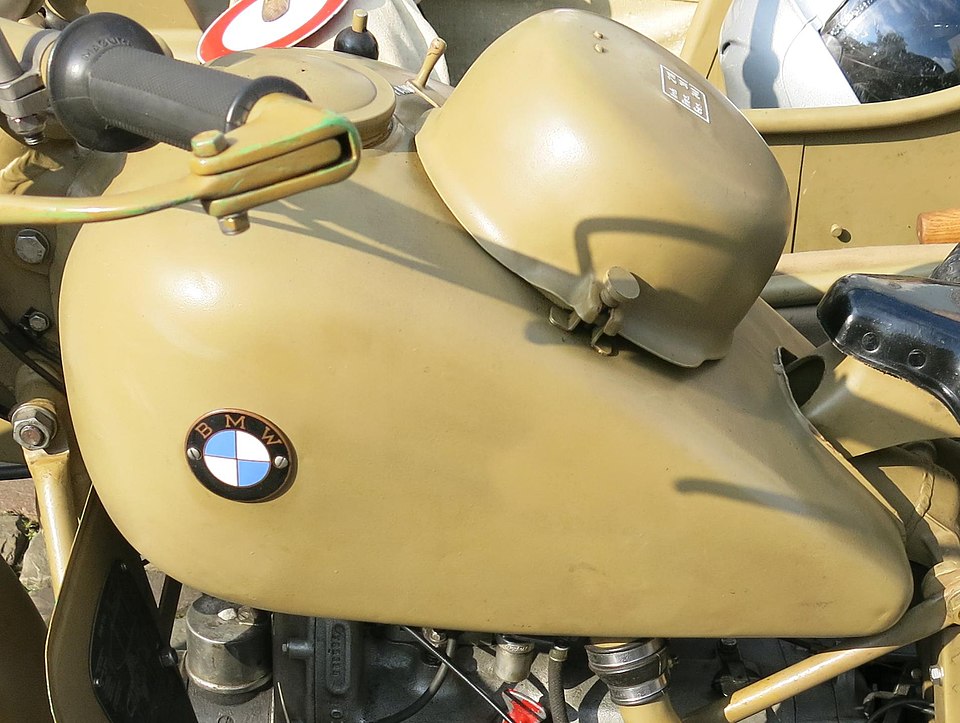 The 1942 air filter
The 1942 air filter
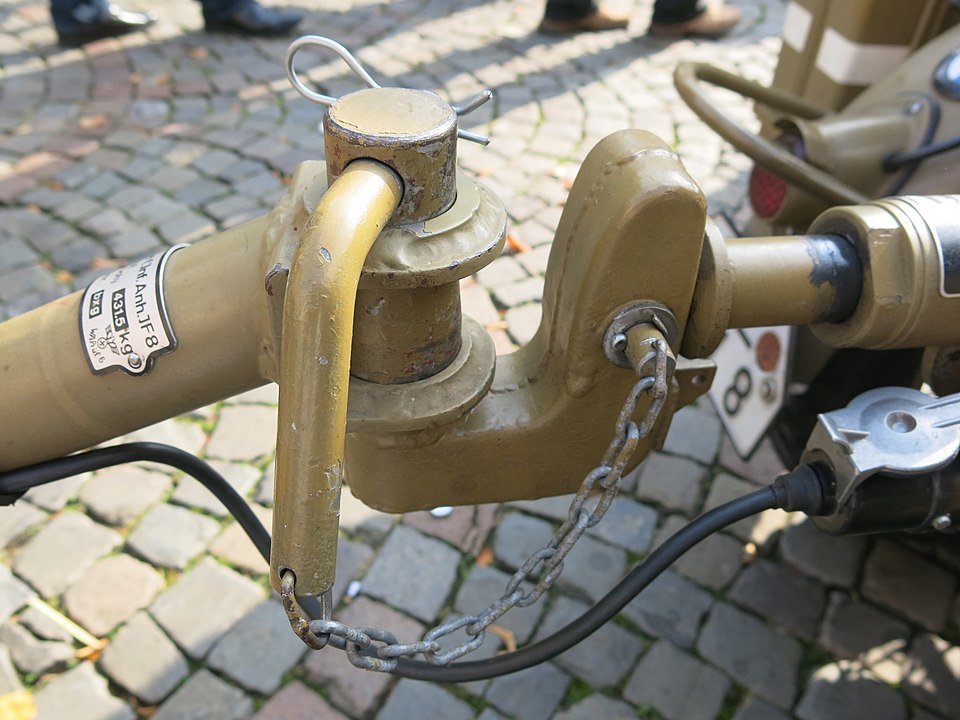 Towing hook
Towing hook
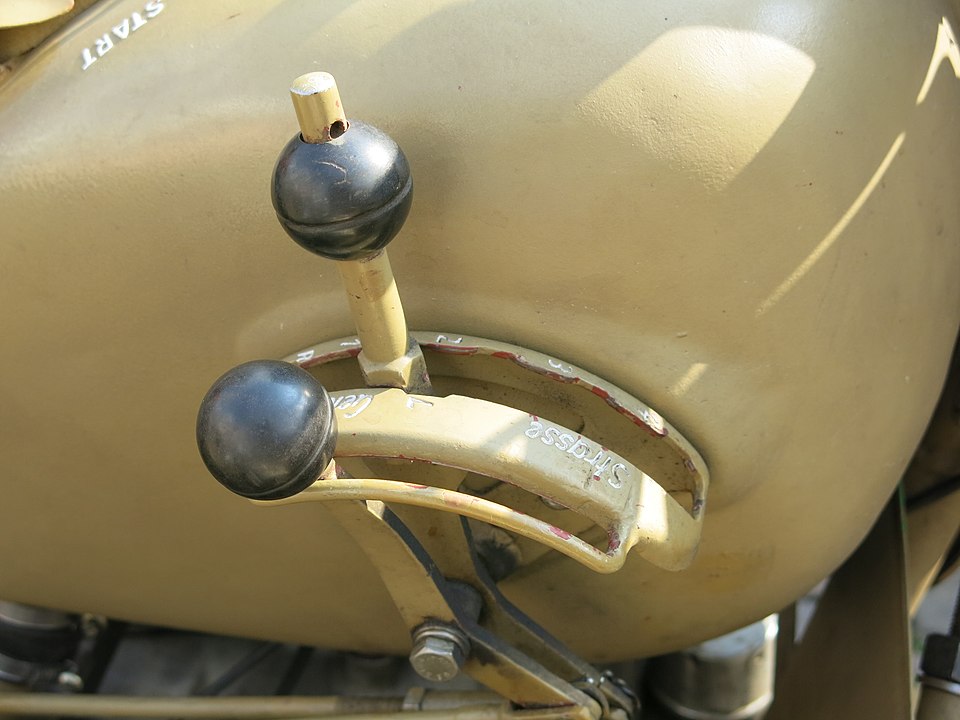 Hand starter
Hand starter
Quick Specs:
- Flat-twin (OHV) Engine with Kick Start (pressure foot pedal)
- Displacement 745 cc
- Maximum Power: 26 hp at 4,400 rpm
- Maximum Torque: 4.9 kgm at 3,600 rpm
- Fuel Supply: 2 Graetzin carburetors (SA 24/1 +2)
- Gearbox 4 (+ reverse on sidecar) an drive Shaft, selectable sidecar wheel drive off-road.
- Maximum Speed 95 km/h, cruise speed c80-85 kph
- Frame: Tubular Steel, Telescopic Fork fwd, Rear Travel Rigid suspensions
- Front Brake with Cable Drum Ø 250 mm, Rear Brake Hydraulic Drum +Sidecar Ø 250 mm
- Front Wheel 4.5 × 16, Rear wheel 4.5 × 16, Wheelbase 1,444 mm, Dry weight 420 kg
- Fuel tank (reserve) 24 L
- Payload: 3 soldiers (rider, passenger, side car gunner), plus equipment.
- Armament: Side car MG34 or MG42 on flexible mount +ammo magazines under the nose.
R75 specifications |
| Dimensions | Ft. wheel 4,5×16, rear 4,5×16, wheelbase 1,444 mm |
| Total weight | 400 kgs (side car) with max payload 274 Kgs. |
| Crew | 1 pilot, 1 passener, 1 MG-gunner in side car. |
| Propulsion | BMW 2-cyl. Boxer OVH 26 hp |
| Top speed | 95 kph |
| Payload | 274 kgs. max |
| Transmission | Drive shaft, rear wheel +side car |
| Suspension | fwd hydraulic Fork, leaf spring side car+ rear wheel. |
| Maximum range (on/off road) | c300 km |
| Armament | MG.34 or MG.42 side car |
| Armor | None (optional) |
| Production | 16,500 |
The BMW R75 in combat
 R75 with the light trailer
R75 with the light trailer
The R75 was a popular model used for reconnaissance, communications, and troop transport. It was valued for mobility but costly and complex to manufacture compared to simpler alternatives like the Zündapp KS 750, with which it shared many parts after standardization. Options included an "Einheitsprotzhaken" trailer hitch, manual gearshift, new air filter on the tank (from Autumn 1942).
The initial total order was 18,000 BMW R 75 sidecars, but according to Werner Oswald, production ended in 1944 after 16,510 units as the design was too complex, too expensive to manufacture at an anerage cost of 2,630 Reichsmarks. From June 1941, production was relocated to the Eisenach and ramped up by October 1942.
Organically the R71 and R75 (as the Zundapp KS 750) were used differently with or without side car configuration. In the former, this model was used for reconnaissance, taking organic part of any vanguard in an "Aufklärungsabteilung" or recon detachment. These were battalion-sized reconnaissance units attached to any German division during the Second World War, ether foot, motorized or Panzer. They were themselves sub-divided in generally four platoons, each provided a vanguard element, with motorcycles such as the BMW R75 and Zündapp KS 750 side cars, then Volkswagen Kübelwagens, and a heavy support following, of Sd.Kfz. 221/222/223 4x4 armored cars.

When used without the side car, which could be mounted or dismounted in the field with limited support in less than a day, the R75 motorcycle could be used at high speed on roads as a liaison vehicle between units, carrying confidential orders from various HQ levels, Corps, divisional, Regimental, down to a platoon.
The R75 was used by the Heer (Army), Luftwaffe (Aviation) and even a few for liaison in the Kriegsmarine (Navy). The Luftwaffe used it notably to patrol the extensive perimeters of forward airfield close to the frontline, notably against partisans, or rapidly ferry pilots and materials, notably important parts between depots and airfields.
Legacy: The Soviet Red Army had nothing comparable in WW2 and the R75 made a big impression, so much so that it led directly to the Ural Motorcycle, IMZ 75, a side car close in designed to the IMZ 71, copied from the BMW R71. Some 9,799 M-72 were produced mixing tech from the R71 and R75. The Chinese Chang Jiang CJ750 is based on the 1956 Soviet Irbitski Mototsikletniy Zavod (IMZ) M-72, and could also trace back its origin in the German 1938 BMW R71 with tech from the R75. Nearly all of them were produced as sidecars.
Due to their sophisticated and robust technology, these Wehrmacht sidecars became highly sought-after collector's items which in top condition, are correspondingly expensive, often over 35,000 euros in 2014. Well-restored sidecar can be driven in everyday life for touring or off-roading and spare parts are still manufactured today by a branch of BMW to maintain roadworthiness. In popular culture the model became famous notably for its apparition in Indiana Jones: The last crusade.
Gallery




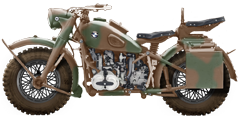
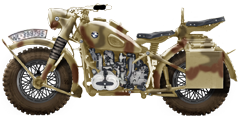
 R75 and pilot resting, Russia, Group South
R75 and pilot resting, Russia, Group South
 R75 and pilot resting, Russia, Group South
R75 and pilot resting, Russia, Group South
 R75 and side car
R75 and side car
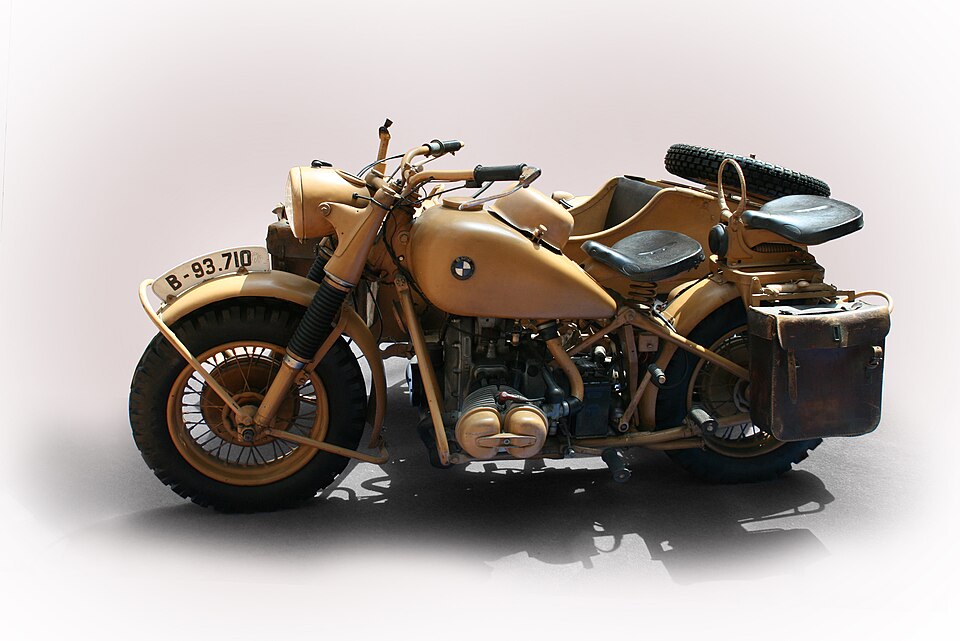 R75 side car in a museum
R75 side car in a museum
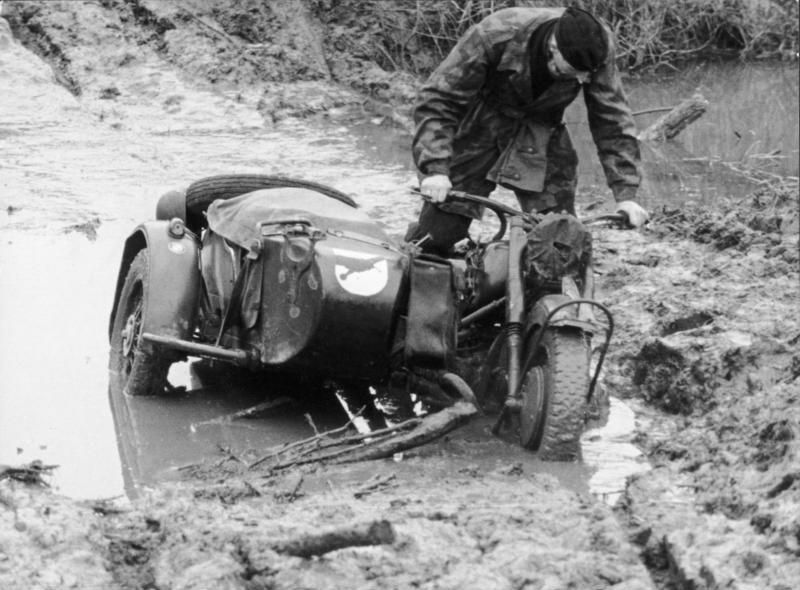 R75 negociating a mud road in Russia
R75 negociating a mud road in Russia
Video
3D
Src
 Full configuration, with side-car (anti-tank company) towing the PAK 36.
slashgear.com
Example of a good condition one carandclassic.com
autoevolution.com
bmw-grouparchiv.de
bmw-grouparchiv.de
bmw-grouparchiv.de
commons.wikimedia.org
de.wikipedia.org
Full configuration, with side-car (anti-tank company) towing the PAK 36.
slashgear.com
Example of a good condition one carandclassic.com
autoevolution.com
bmw-grouparchiv.de
bmw-grouparchiv.de
bmw-grouparchiv.de
commons.wikimedia.org
de.wikipedia.org